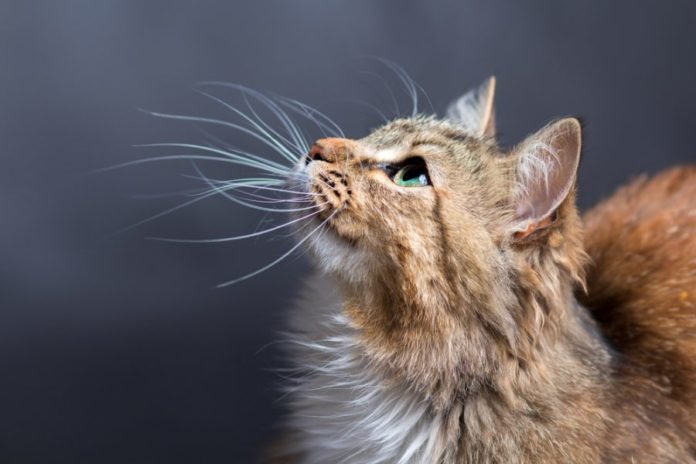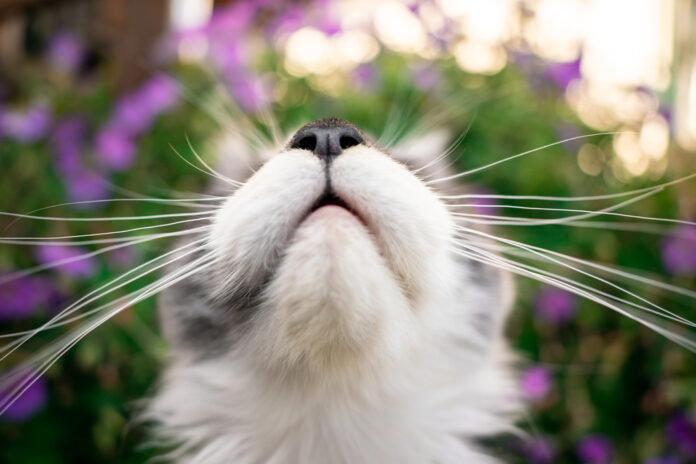Does your cat have whisker stress?

Food and water bowls that are too small can result in a feline behavioral issue called whisker stress.
Does your cat pull her food out of her bowl before she eats it, leaving a mess for you to clean up? Or does she only eat a few mouthfuls from the top of her dish and then beg for more, completely ignoring what’s left? You might think she’s a picky eater, but there’s probably a valid reason why she’s doing this, and it’s not just to make your life difficult. She may have what’s called whisker stress.
What in the world is whisker stress?
To really understand this issue, let’s take a look at your cat’s whiskers. Whiskers provide cats (and all other mammals) with information about the objects they come into contact with. Many cats’ whiskers are so finely tuned that they can even pick up air movement. They help enhance the cat’s senses, particularly short-distance vision. Although whiskers look like a type of hair, they’re actually rich in blood vessels and nerve endings, so they’re extraordinarily sensitive. They help cats navigate through their surroundings.
A cat typically has between eight and 12 whiskers on each side of her face, as well as shorter whiskers on her chin, above her eyes, and even on her legs. Each whisker is essentially set up to transmit information about pressure being applied along its length to its base, which contains the follicle and receptors. The tip of each whisker has proprioceptors, sensory organs that are incredibly sensitive to even to the slightest pressure. Cats can use their whiskers to determine how far away an object is, where it’s located, and – quite amazingly – even its texture.
“The tip of each whisker has proprioceptors, sensory organs that are incredibly sensitive to even to the slightest pressure.”
Why does this affect a cat’s eating habits?
So what does all this have to do with your cat’s mealtime habits? Well, because the proprioceptors in her whiskers are so incredibly sensitive, it can actually be painful for her to eat or drink out of a bowl that’s too narrow to accommodate her whiskers without having them touch the sides. This is why some cats will use their paws to scoop food out of their bowls, or only eat off the very top of the bowl. In some instances, you may notice that your cat seems reluctant to eat even though she’s clearly hungry. She may meow at the bowl, even if there is food in it, pace around it, or stand beside it for a while before eating. In all these examples, the cat is trying to avoid having to cram her sensitive whiskers into the bowl, something that’s very uncomfortable for her.
To give you an idea of just how sensitive a cat’s whiskers are, consider this: if a single whisker moves 1/200th the width of a human hair, it sends a signal to the cat’s brain. Now picture how intense the signal must be if the cat has to push her whole face into a bowl, smashing her whiskers up against the sides while trying to eat. Because the cat’s whiskers have evolved to give her information about their environment, and to make sure, for example, that she is able to navigate through narrow spaces safely, a bowl that’s too small means her whiskers are constantly sending signals to her brain that the space is too narrow and she need to stop trying to fit her head in it.
What can you do to solve the problem?
Luckily, the fix is relatively simple. Just start feeding and watering your cat from bowls that take the span of her whiskers into account. The bowls should be both wide enough and shallow enough that her whiskers don’t touch the sides, even if she put their whole head in to get at food on the very bottom. You can use a shallow plate or saucer, or purchase a bowl specifically designed to relieve whisker stress. Some good options are Dr. Catsby’s Bowl for Whisker Relief or Trendy Pet’s Whisker Free Stress raised bowl.
“You can use a shallow plate or saucer, or purchase a bowl specifically designed to relieve whisker stress.”
Using appropriately sized and shaped dishes will eliminate whisker stress and make your cat’s mealtimes much more comfortable and relaxing – and it’ll cut down on clean-up too!



